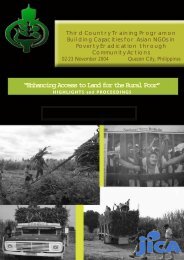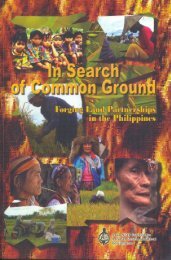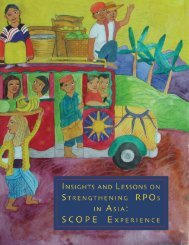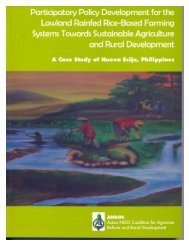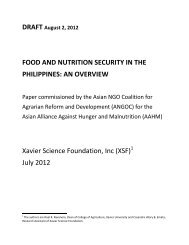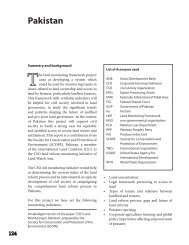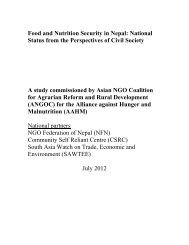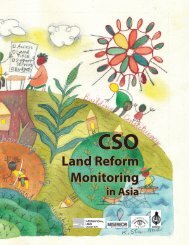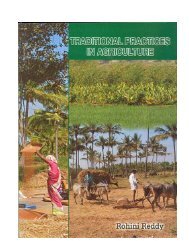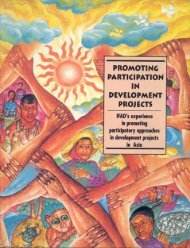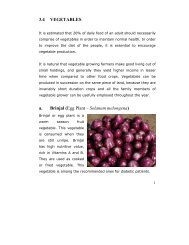Securing the Right to Land FULL - ANGOC
Securing the Right to Land FULL - ANGOC
Securing the Right to Land FULL - ANGOC
You also want an ePaper? Increase the reach of your titles
YUMPU automatically turns print PDFs into web optimized ePapers that Google loves.
SECURING THE RIGHT TO LAND100<br />
ticularly through agrarian-oriented land management and<br />
land-use planning; facilitation of rural employment opportunities<br />
outside of agriculture, including <strong>the</strong> development<br />
of rural agro-industries; diversification of rural sec<strong>to</strong>r products;<br />
development of infrastructure; and developing <strong>the</strong><br />
institutions of farmers, fishers and agro-foresters along with<br />
fulfilling <strong>the</strong>ir basic rights;<br />
Increasing <strong>the</strong> competitiveness, productivity, value-added<br />
and independence of production and distribution in <strong>the</strong> sec<strong>to</strong>rs,<br />
primarily through better agricultural practices; developing<br />
new activities and multi-products; increasing access<br />
<strong>to</strong> services, and reducing or removing obstacles and high<br />
economic costs <strong>to</strong> productive activities; and protecting work<br />
activities against unfair competition;<br />
A sustainable approach <strong>to</strong> <strong>the</strong> use and protection of natural<br />
resources, primarily through conservation management and<br />
an agrarian approach <strong>to</strong> land management and land useplanning;<br />
along with encouraging <strong>the</strong> development of activities,<br />
technology, and institutions which are<br />
environmentally friendly; and streng<strong>the</strong>ning <strong>the</strong> rule of law.<br />
The RPPK document is expected <strong>to</strong> be a framework for <strong>the</strong> longterm—i.e.,<br />
<strong>the</strong> next 20 years—but would be evaluated every six<br />
months and renewed annually. A Committee on Revitalization<br />
of Agriculture, Fisheries, and Forestry would be created, and<br />
would be chaired by <strong>the</strong> Minister for Economic Affairs. The Ministers<br />
for Agriculture, Maritime and Fishing, and Forestry would<br />
act as vice-chairs, and members from o<strong>the</strong>r ministers, governors,<br />
<strong>the</strong> Indonesian Chamber of Commerce, and o<strong>the</strong>rs, would<br />
be called on <strong>to</strong> participate as needed.<br />
<strong>Land</strong> regulation is cited as an important component of agricultural<br />
revitalization in <strong>the</strong> RPPK document, but this task would<br />
be conducted against <strong>the</strong> framework of <strong>the</strong> fully discredited<br />
Green Revolution technologies.<br />
Multilateral Development Agencies and<br />
Financial Institutions<br />
Observers in Indonesia have noted <strong>the</strong> increasing involvement<br />
of multilateral development agencies (<strong>the</strong> World Bank Group)<br />
and international financial institutions (<strong>the</strong> International Monetary<br />
Fund) in integrating free trade and <strong>the</strong> allocation of agrarian<br />
resources. This is exemplified by <strong>the</strong> process and outcome of<br />
<strong>the</strong> <strong>Land</strong> Administration Project (LAP). The LAP is a huge undertaking<br />
of <strong>the</strong> Government of Indonesia (represented by <strong>the</strong> National<br />
<strong>Land</strong> Agency, <strong>the</strong> National Planning Agency, and <strong>the</strong><br />
Ministry for Economic Affairs), <strong>the</strong> World Bank (WB), and Australian<br />
Aid (AusAid). For <strong>the</strong> first phase of LAP (1995–2000), <strong>the</strong><br />
WB gave a loan <strong>to</strong> <strong>the</strong> Government of Indonesia amounting <strong>to</strong><br />
US$80 million. The project would run for 25 years (1995–2020).<br />
The LAP seeks <strong>to</strong> establish a “land market” and <strong>to</strong> make <strong>the</strong> administration<br />
of land more effective and efficient in order <strong>to</strong><br />
make land more readily available for activities promoting capital<br />
growth in <strong>the</strong> country. In support of this project, <strong>the</strong> Government<br />
repealed <strong>the</strong> law on land registration (Government Regulation<br />
No. 10 of 1961—regarded as one of <strong>the</strong> corners<strong>to</strong>nes of<br />
agrarian reform implementation—and replaced it with a watered<br />
down version (Government Regulation No. 24 of 1997).<br />
Henceforth, <strong>the</strong> supply of land in Indonesia would be determined<br />
by <strong>the</strong> market. This is expected <strong>to</strong> exacerbate <strong>the</strong> already<br />
unequal distribution and control of land in <strong>the</strong> country.<br />
Moreover, big infrastructure projects funded by <strong>the</strong> WB and <strong>the</strong><br />
Asian Development Bank (ADB), for example, have resulted in<br />
violations of people’s and peasant’s rights. The Kedung Ombo<br />
Dam project in <strong>the</strong> Central Java province (funded by <strong>the</strong> WB<br />
during Suhar<strong>to</strong>’s administration), <strong>the</strong> Jatigede Dam project in<br />
Sumedang, West Java (funded by <strong>the</strong> Chinese government during<br />
President Yudhono’s term), and <strong>the</strong> Nipah Dam project—<br />
which is one of biggest infrastructure projects implemented in<br />
<strong>the</strong> country—are a few of those projects which are much reviled<br />
among <strong>the</strong> affected communities.<br />
Civil Society Organizations and NGOs<br />
Civil society organizations (CSOs) and NGOs in Indonesia have<br />
laid <strong>the</strong> blame for <strong>the</strong> country’s agrarian crisis on three fac<strong>to</strong>rs.<br />
First is <strong>the</strong> concentration of <strong>the</strong> ownership of land and o<strong>the</strong>r<br />
natural resources on a small group of owners: ei<strong>the</strong>r big landlords—scions<br />
of old landed families—who maintain feudal or<br />
semi-feudal modes of production; or big corporations, <strong>to</strong> which<br />
<strong>the</strong> Government has rented out land <strong>to</strong> engage in mining, agroindustry,<br />
forestry, or <strong>the</strong> running of plantations.<br />
The big corporations have been observed <strong>to</strong> be <strong>the</strong> more dangerous<br />
and reactionary type of landowners. They are ready and able<br />
<strong>to</strong> secure <strong>the</strong>ir interests, including using violence <strong>to</strong> put down<br />
local resistance. A few examples of <strong>the</strong> big plantations are<br />
Perum Perhutani and PT Inhutani. Transnational mining corporations<br />
like Freeport, Newmont, and Kaltim Prima Coal (Rio Tin<strong>to</strong><br />
Ltd), and transnational petroleum corporations like Exxon, Caltex,



